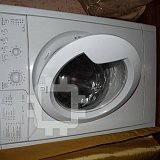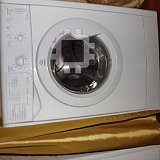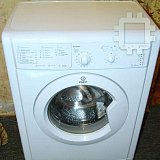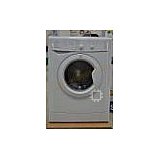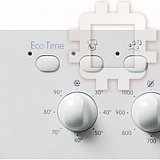Indesit IWB 5105: instruction
Class: Household, kitchen appliances, electronics and equipment
Type: Laundry Machine
Manual for Indesit IWB 5105
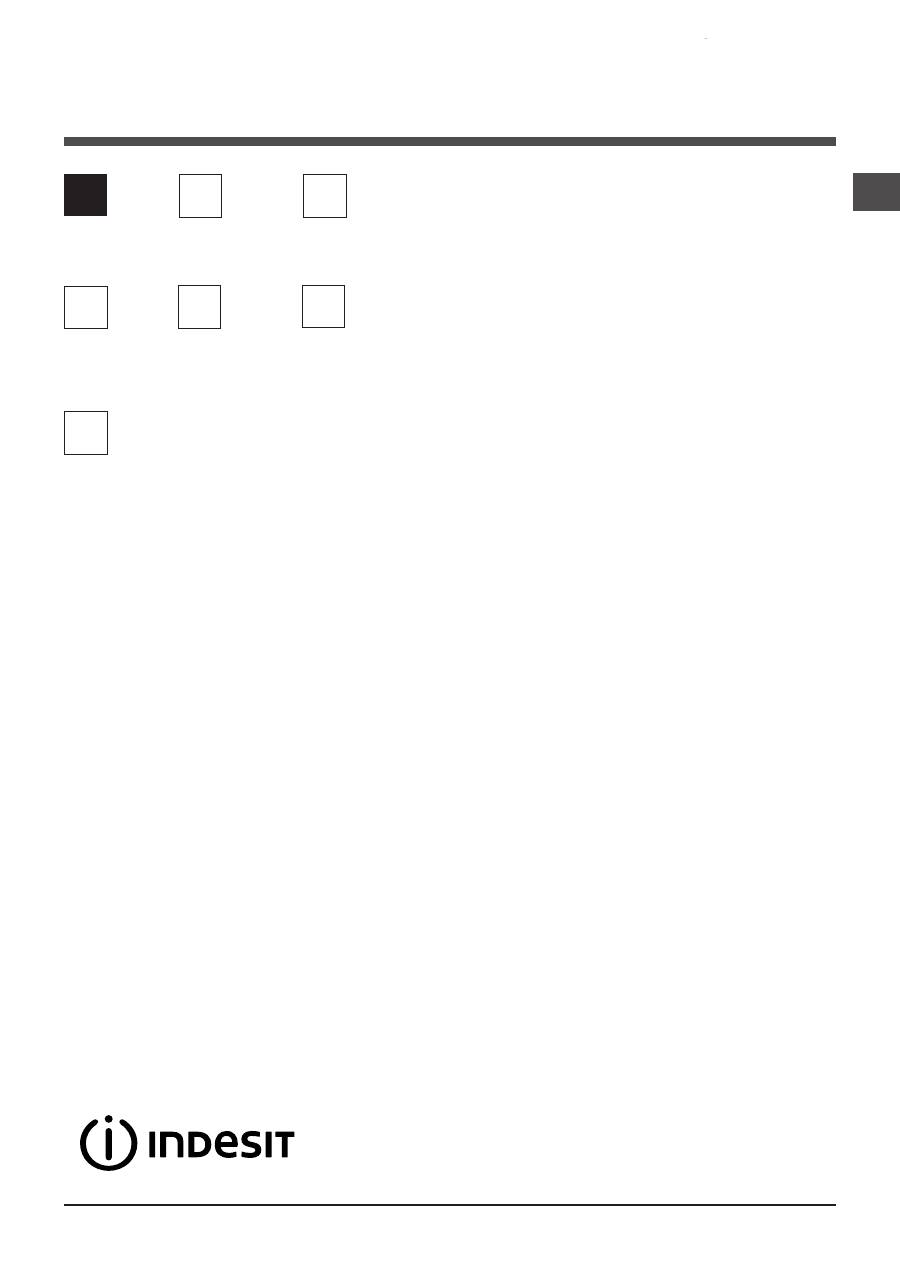
GB
1
Contents
Installation, 2-3
Unpacking and levelling
Connecting the electricity and water supplies
The first wash cycle
Technical data
Care and maintenance, 4
Cutting off the water or electricity supply
Cleaning the washing machine
Cleaning the detergent dispenser drawer
Caring for the door and drum of your appliance
Cleaning the pump
Checking the water inlet hose
Precautions and tips, 5
General safety
Disposal
Description of the washing machine
and starting a wash cycle, 6-7
Control panel
Indicator lights
Starting a wash cycle
Wash cycles, 8
Table of wash cycles
Personalisation, 9
Setting the temperature
Functions
Detergents and laundry, 10
Detergent dispenser drawer
Preparing the laundry
Garments requiring special care
Load balancing system
Troubleshooting, 11
Service, 12
Instructions for use
WASHING MACHINE
IWB 5105
English,1
GB
Deutsch,13
DE
Slovensko,25
SL
Hrvatski,37
HR
Românã,49
RO
Русский,61
CSI
Italiano,73
I

2
GB
Installation
!
This instruction manual should be kept in a safe
place for future reference. If the washing machine
is sold, transferred or moved, make sure that the
instruction manual remains with the machine so
that the new owner is able to familiarise himself/
herself with its operation and features.
!
Read these instructions carefully: they contain
vital information relating to the safe installation
and operation of the appliance.
Unpacking and levelling
Unpacking
1. Remove the washing machine from its packaging.
2. Make sure that the washing machine has not
been damaged during the transportation process.
If it has been damaged, contact the retailer and do
not proceed any further with the installation process.
3. Remove the
3
pro-
tective screws (used
during transportation)
and the rubber washer
with the corresponding
spacer, located on the
rear part of the applian-
ce (
see figure
).
4. Close off the holes using the plastic plugs
provided.
5. Keep all the parts in a safe place: you will need
them again if the washing machine needs to be
moved to another location.
!
Packaging materials should not be used as
toys for children.
Levelling
1. Install the washing
machine on a flat stur-
dy floor, without resting
it up against walls,
furniture cabinets or
anything else.
2. If the floor is not
perfectly level, com-
pensate for any une-
venness by tightening
or loosening the adjustable front feet (
see figure
);
the angle of inclination, measured in relation to
the worktop, must not exceed 2°.
Levelling the machine correctly will provide it with
stability, help to avoid vibrations and excessive
noise and prevent it from shifting while it is ope-
rating. If it is placed on carpet or a rug, adjust the
feet in such a way as to allow a sufficient venti-
lation space underneath the washing machine.
Connecting the electricity and wa-
ter supplies
Connecting the water inlet hose
1. Connect the supply
pipe by screwing it to
a cold water tab using
a ¾ gas threaded con-
nection
(see figure).
Before performing the
connection, allow the
water to run freely until
it is perfectly clear.
2. Connect the inlet
hose to the washing
machine by screwing
it onto the correspon-
ding water inlet of the
appliance, which is si-
tuated on the top right-
hand side of the rear
part of the appliance
(see figure)
.
3. Make sure that the hose is not folded over
or bent.
!
The water pressure at the tap must fall within
the values indicated in the Technical details table
(see next page).
!
If the inlet hose is not long enough, contact a
specialised shop or an authorised technician.
!
Never use second-hand hoses.
!
Use the ones supplied with the machine.

GB
3
Technical data
Model
IWB 5105
Dimensions
width 59,5 cm
height 85 cm
depth 52,5 cm
Capacity
from 1 to 5 kg
Electrical
connections
please refer to the technical
data plate fixed to the machine
Water
connection
maximum pressure
1 MPa (10 bar)
minimum pressure
0.05 MPa (0.5 bar)
drum capacity 46 litres
Spin speed
up to 1000 rotations per
minute
Test wash
cycles in ac-
cordance with
directives
1061/2010
and
1015/2010.
Programme 3:
Cotton standard 60°C;
Programme 4:
Cotton standard 40°C.
This appliance conforms to
the following EC Directives:
- 2004/108/CE (Electroma-
gnetic
Compatibility)
- 2002/96/EC
- 2006/95/EC Low Voltage)
65 - 100 cm
Connecting the drain hose
Connect the drain
hose, without bending
it, to a drainage duct or
a wall drain located at a
height between 65 and
100 cm from the floor;
alternatively, rest it on
the side of a washba-
sin or bathtub, faste-
ning the duct supplied
to the tap (
see figure
).
The free end of the
hose should not be
underwater.
!
We advise against the use of hose extensions;
if it is absolutely necessary, the extension must
have the same diameter as the original hose and
must not exceed 150 cm in length.
Electrical connections
Before plugging the appliance into the electricity
socket, make sure that:
• the socket is earthed and complies with all
applicable laws;
• the socket is able to withstand the maximum
power load of the appliance as indicated in the
Technical data table
(see opposite);
• the power supply voltage falls within the values
indicated in the Technical data table
(see opposite);
• the socket is compatible with the plug of the
washing machine. If this is not the case, repla-
ce the socket or the plug.
!
The washing machine must not be installed
outdoors, even in covered areas. It is extremely
dangerous to leave the appliance exposed to
rain, storms and other weather conditions.
!
When the washing machine has been installed,
the electricity socket must be within easy reach.
!
Do not use extension cords or multiple sockets.
!
The cable should not be bent or compressed.
!
The power supply cable must only be replaced
by authorised technicians.
Warning! The company shall not be held responsible
in the event that these regulations are not respected.
The first wash cycle
Once the appliance has been installed, and
before you use it for the first time, run a wash
cycle with detergent and no laundry, using the
wash cycle
2
.

4
GB
Care and maintenance
Cutting off the water and electricity
supplies
• Turn off the water tap after every wash cycle.
This will limit wear on the hydraulic system in-
side the washing machine and help to prevent
leaks.
• Unplug the washing machine when cleaning it
and during all maintenance work.
Cleaning the washing machine
The outer parts and rubber components of the
appliance can be cleaned using a soft cloth
soaked in lukewarm soapy water. Do not use
solvents or abrasives.
Cleaning the detergent dispenser
drawer
Remove the dispenser
by raising it and pulling
it out (
see figure
).
Wash it under running
water; this operation
should be repeated
frequently.
Caring for the door and drum of
your appliance
• Always leave the porthole door ajar in order to
prevent unpleasant odours from forming.
Cleaning the pump
The washing machine is fitted with a self-clea-
ning pump which does not require any mainte-
nance. Sometimes, small items (such as coins
or buttons) may fall into the pre-chamber which
protects the pump, situated in its bottom part.
!
Make sure the wash cycle has finished and
unplug the appliance.
To access the pre-chamber:
1. using a screwdriver,
remove the cover pa-
nel on the lower front
part of the washing
machine (
see figure
)
;
2. unscrew the lid by
rotating it anti-clockwi-
se (
see
figure
)
:
a little
water may trickle out.
This is perfectly nor-
mal;
3. clean the inside thoroughly;
4. screw the lid back on;
5. reposition the panel, making sure the hooks
are securely in place before you push it onto the
appliance.
Checking the water inlet hose
Check the inlet hose at least once a year. If there
are any cracks, it should be replaced immedia-
tely: during the wash cycles, water pressure is
very strong and a cracked hose could easily
split open.
!
Never use second-hand hoses.
Table of contents
- Installation
- Care and maintenance
- Precautions and tips
- Description of the washing machine and starting a wash cycle
- Wash cycles
- Personalisation
- Detergents and laundry
- Troubleshooting
- Service
- Bedienungsanleitungen
- Installation
- Reinigung und Pflege
- Vorsichtsmaßregeln und Hinweise
- Waschprogramme
- Personalisierungen
- Waschmittel und Wäsche
- Störungen und Abhilfe
- Kundendienst
- Navodila za uporabo
- Namestitev
- Vzdrževanje in čiščenje
- Opozorila in nasveti
- Opis pralnega stroja in zagon programa
- Programi
- Posebne nastavitve
- Pralna sredstva in perilo
- Motnje in njihovo odpravljanje
- Pomoč
- Upute za uporabu
- Postavljanje
- Opis perilice rublja i pokretanje programa
- Programi
- Osobni izbor
- Deterdžent i rublje
- Mjere predostrožnosti i savjeti
- Održavanje i očuvanje
- Nepravilnosti i rješenja
- Servisna služba
- Instrucţiuni de folosire
- Instalare
- Întreţinere şi curăţare
- Precauţii şi sfaturi
- Descrierea maşinii de spălat şi activarea unui program
- Programe
- Personalizare
- Detergenţi şi rufe albe
- Anomalii şi remedii
- Asistenţă
- Руководство по эксплуатации
- Установка
- Описание стиральной машины и порядка запуска программы
- Программы
- Персонализированные настройки
- Моющие средства и типы белья
- Предосторожности и рекомендации
- Техническое обслуживание и уход
- Поиск неисправностей и методы их устранения
- Сервисное обслуживание
- Istruzioni per l’uso
- Installazione
- Manutenzione e cura
- Precauzioni e consigli
- Descrizione della lavabiancheria e avviare un programma
- Programmi
- Personalizzazioni
- Detersivi e biancheria
- Anomalie e rimedi
- Assistenza

